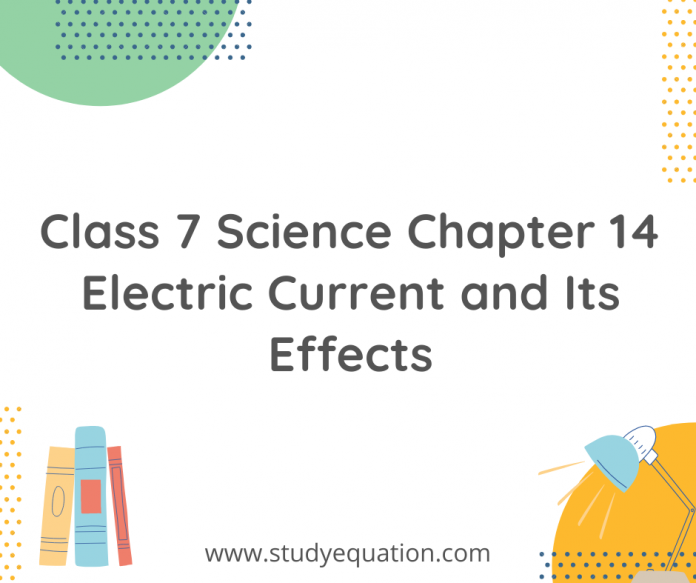Along with NCERT Solutions For Class 7 Science Chapter 14 Electric Current and Its Effects, we also provide Notes and Lesson Plan made specially by our Study Rankers for better understanding. Students may read the NCERT Science Chapter 14 PDF to practice concepts with NCERT Solutions and Extra Questions prepared by keeping in mind the latest CBSE curriculum. Shine among your friends after scoring high in Quiz and Worksheet.
Read more: NCERT Solutions For Class 7 Science Chapter 7 Weather, Climate and Adaptations of Animals to Climate
Table of Contents
Notes For NCERT Solutions For Class 7 Science Chapter 14 Electric Current and Its Effects
(Also find NCERT Solutions For Class 7 Science Chapter 14 Electric Current and Its Effects given below)
Symbols of Electric Components
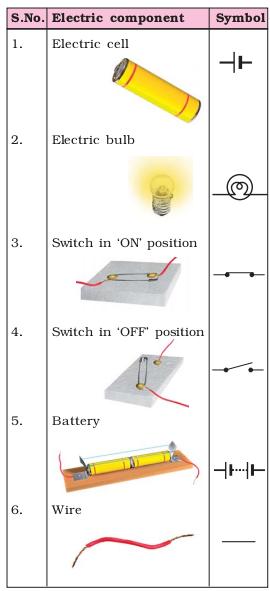
- In the symbol of the electric cell, the longer line represents the positive terminal and the thicker, shorter line represents the negative terminal.
- Lines represent the wires used to connect the various components in a circuit.
- A attery is a combination of two or more cells.
- One must connect the positive terminal of one cell to the negative terminal of the next cell.
- In the bulb there is a thin wire, the filament, which glows when an electric current passes through it. When the filament breaks, the bulb fuses.
Closed Circuit vs. Open Circuit
| Closed Circuit | Open Circuit |
| When the switch is in the ‘ON’ position, the circuit from the positive terminal of the battery to the negative terminal is complete. The circuit is then said to be closed and the current flows throughout the circuit instantly. | When the switch is in the ‘OFF’ position, the circuit is incomplete. It is said to be open. No current flows through any part of the circuit. |
Heating Effect of Electric Current
- A wire gets hot when an electric current passes through it. This is the heating effect of the electric current.
- Heating appliances contain a coil of wire. This coil of wire is called an element.
- Electrical appliances, such as immersion heaters, hotplates, irons, geysers, electric kettles, hair dryers, have elements inside them.
- The elements become red and hot, it emits heat and light due to electric current in the circuit.
- The amount of heat produced in a wire depends on its material, length and thickness.
- An electric bulb glows because filament heats up such a high temperature that it starts glowing.
- If a large current passes through a wire, the wire may become so hot that it may even melt and break.
- When large electric currents pass through the wires made from some special materials, they melt quickly and break . Electric fuses comprise of these wires.
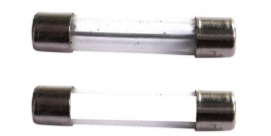
Fuses
- There is a maximum limit on the current which can safely flow through a circuit.
- If by accident the current exceeds this safe limit, the wires may become overheated and may cause fire.
- If a proper fuse is there in the circuit, it will blow off and break the circuit.
- A fuse is thus a safety device which prevents damages to electrical circuits and possible fires.
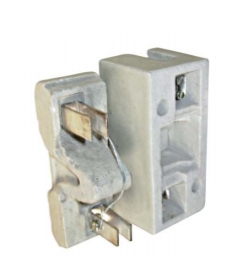
Causes for Short Circuit
- One reason for excessive currents in electrical circuits is the direct touching of wires. This may happen if the insulation on the wires has come off due to wear and tear. This may cause a short circuit.
- Another reason for excessive current can be the connection of many devices to a single socket. This may cause overload in the circuit.
Miniature Circuit Breaker (MCB)
- In place of fuses, use of Miniature circuit breakers (MCBs) is increasing.
- These are switches which automatically turn off when current in a circuit exceeds the safe limit.
- You turn them on and the circuit is once again complete.
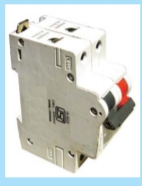
Compact Fluorescent Lamp (CFL)
- We use n electric bulb for light but it also gives heat. This is not desirable. This results in the wastage of electricity.
- Use of Compact fluorescent lamps (CFLs) reduces wastage and it fixes easily in the ordinary bulb holders.
Magnetic Effect Of Electric Current
- When electric current passes through a wire, it behaves like a magnet. This is the magnetic effect of the electric current.
- Hans Christian Oersted observed this effect.
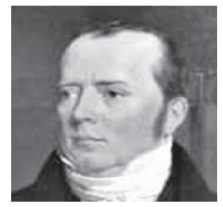
Electromagnet
- A coil behaves like a magnet when electric current flows through it.
- Switching off of electric current causes the losing of magnetism from this coil.
- This coil is electromanget. Learn more about electromanget.
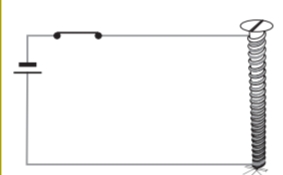
Importance of Electromagnets
- The end of a crane has a strong electromagnet attached to it.
- To separate magnetic material from the junk, we use electromagnets.
- Doctors use tiny electromagnets to take out small pieces of magnetic material that have accidentally fallen in the eye.
- Many toys also have electromagnets inside them.
Electric Bell
Composition Of Electric Bells
- It consists of a coil of wire wound on an iron piece. The coil acts as an electromagnet.
- An iron strip.
- A hammer at one end is close to the electromagnet.
- There is a contact screw near the iron strip.
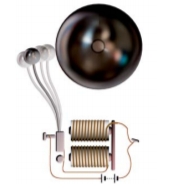
Working Of Electric Bell
- When the iron strip is in contact with the screw, the current flows through the coil which becomes an electromagnet.
- It, then, pulls the iron strip. In the process, the hammer at the end of the strip strikes the gong of the bell to produce a sound.
- However, when the electromagnet pulls the iron strip, it also breaks the circuit. The current through the coil stops flowing.
- The coil is no longer an electromagnet. It no longer attracts the iron strip. The iron strip comes back to its original position and touches the contact screw again. This completes the circuit.
- The current flows in the coil and the hammer strikes the gong again.
- This process is repeated in quick succession.
- Every time the circuit is completed, the hammer strikes the . This is how the bell rings.
NCERT Solutions For Class 7 Science Chapter 14 Electric Current and Its Effects
(Also find NCERT Solutions For Class 7 Science Chapter 14 Electric Current and Its Effects FAQs given below)
Q. 1. Draw in your notebook the symbols to represent the following components of electrical circuits: connecting wires, switch in the ‘OFF’ position, bulb, cell, switch in the ‘ON’ position and battery.
A)
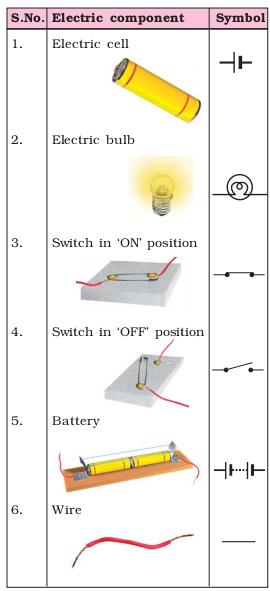
Q. 2. Draw the circuit diagram to represent the circuit shown in fig below.
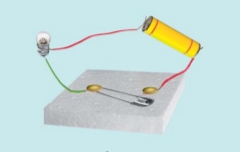
A)
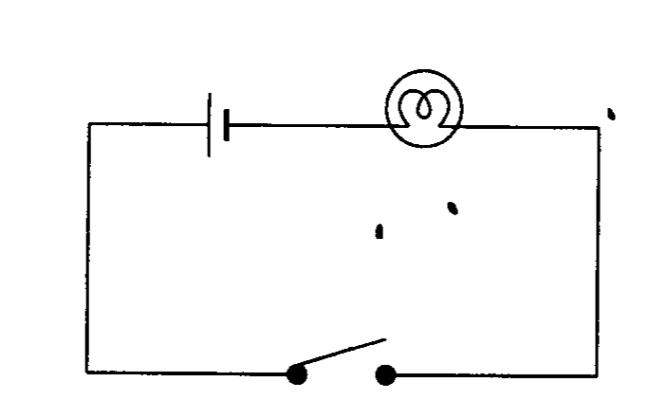
Q. 3. Fig. given below shows four cells fixed on a board. Draw lines to indicate how you will connect their terminals with wires to make a battery of four cells.
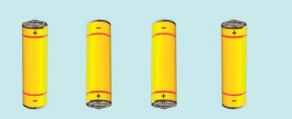
A)
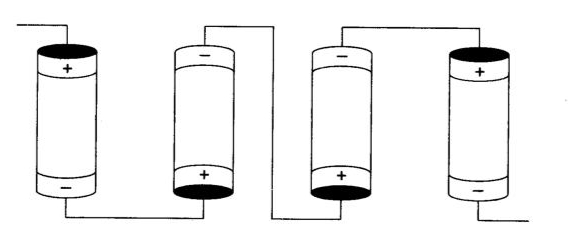
Q. 4. The bulb in the circuit shown in fig. given below does not glow. Can you identify the problem? Make necessary changes in the circuit to make the bulb glow
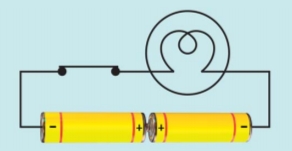
A) When positive terminal of the cell connects to negative terminal of the cell,the circuit becomes complete. The bulb does not glow because in this fig. , the positive terminal of one joins to positive terminal of another cell.
Q. 5. Name any two effects of electric current.
A) Electric current has two effects:
- A wire gets hot when an electric current passes through it. This is the heating effect of the electric current.
- When electric current passes through a wire, it behaves like a magnet. This is the magnetic effect of the electric current.
Q. 6. When the current is switched on through a wire, a compass needle kept nearby gets deflected from its north-south position. Explain.
A) We know that the needle of a compass is a tiny magnet, which points in north-south direction. The needle deflects, when we bring a magnet close to it, When the current flows through a wire, the wire behave like a magnet which causes the deflection of compass needle every time the current passes through the wire.
Q. 7. Will the compass needle show deflection when the switch in the circuit shown by fig. given below is closed?
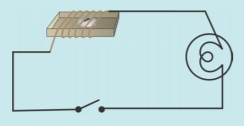
A) Since there is absence of a cell or battery, there will be no flow of electric current and hence there will be no deflection.
Q. 8. Fill in the blanks:
- Longer line in the symbol for a cell represents its ___________terminal
- The combination of two or more cells is called a ____________.
- When current is switched ‘on’ in a room heater, it ___________.
- The safety device based on the heating effect of electric current is called a _____________.
A)
- Longer line in the symbol for a cell represents its positive terminal
- The combination of two or more cells is called a battery.
- When current is switched ‘on’ in a room heater, it emits heat.
- The safety device based on the heating effect of electric current is called a fuse.
Q. 9. Mark ‘T’ if the statement is true and ‘F’ it is a false:
- To make a battery of two cells, the negative terminal of one cell is connected to the negative terminal of the other cell. [T/F]
- When the electric current through the fuse exceeds a certain limit , the fuse wire melts and breaks. [T/F]
- An electromagnet does not attract a piece of iron. [T/F]
- An electric bell has an electromagnet. [T/F]
A)
- To make a battery of two cells, the negative terminal of one cell is connected to the negative terminal of the other cell. FALSE
- When the electric current through the fuse exceeds a certain limit , the fuse wire melts and breaks. TRUE
- An electromagnet does not attract a piece of iron. FALSE
- An electric bell has an electromagnet. TRUE
Q. 10. Do you think an electromagnet can be used for separating plastic bags from a garbage heap? Explain.
A) Plastic bags are not magnetic materials and hence, electromagnet will not attract plastic bags and we can’t separate plastic bags from garbage heap.
Q. 11. An electrician is carrying out some repairs in your house. He wants to replace a fuse by a piece of wire. Would you agree? Give reasons for your response.
A) A fuse is a safety device which prevents damages to electrical circuits and possible fires. Therefore, I will not agree to replace a fuse by a piece of wire.
Q. 12. Zubeda made an electric circuit using a cell holder, a switch and a bulb. When she put the switch in the ‘ON’ position, the bulb did not glow. Help Zubeda in identifying the possible defects in the circuit.
A) The possible defects in the circuit might be:
- The cells might not be in proper connection.
- Zubeda must close the switch properly.
- Zubeda must be using a fuse bulb.
Q. 13. In the circuit shown in fig. given below, would any of the bulb glow when the switch is in the ‘OFF’ position? What will be the order in which the bulbs A, B and C will glow when the switch is moved to the ‘ON’ position?
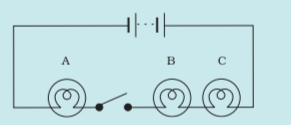
A) If switch is off, none of the bulbs will glow. ll the bulbs will glow simultaneously, when the switch is turned on.
Some Frequently Asked Questions
(Here you can find the NCERT Solutions For Class 7 Science Chapter 14 Electric Current and Its Effects FAQs.)
Q. 1. Sometimes the cells are placed side by side. Then how are the terminals of the cells connected?
A) There is usually a thick wire or a metal strip connecting the positive terminal of one cell to the negative terminal of the next cell.
Q. 2. The batteries used in tractors, trucks and inverters are also made from cells. Then why is it called a battery?
A) The battery used in tractors, trucks and inverters is a combination of several cells. Hence, it is a battery.
Conclusion: NCERT Solutions For Class 7 Science Chapter 14 Electric Current and Its Effects
Above written includes NCERT Solutions For Class 7 Science Chapter 14 Electric Current and Its Effects, detailed Explanation, and Question Answers. Browse our site for various detailed and easy NCERT Solutions and CBSE Notes.

